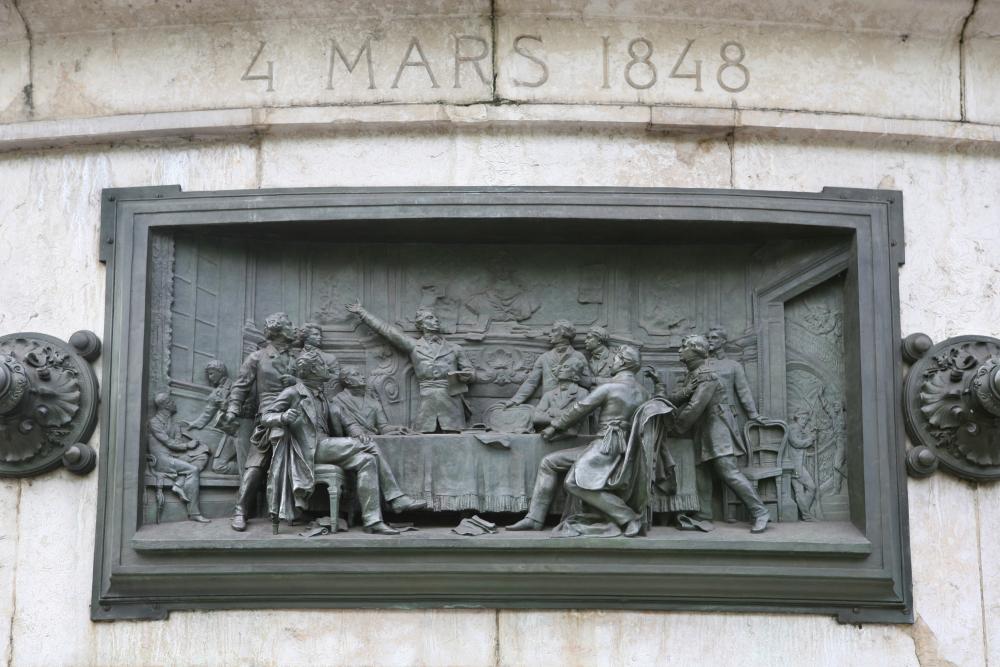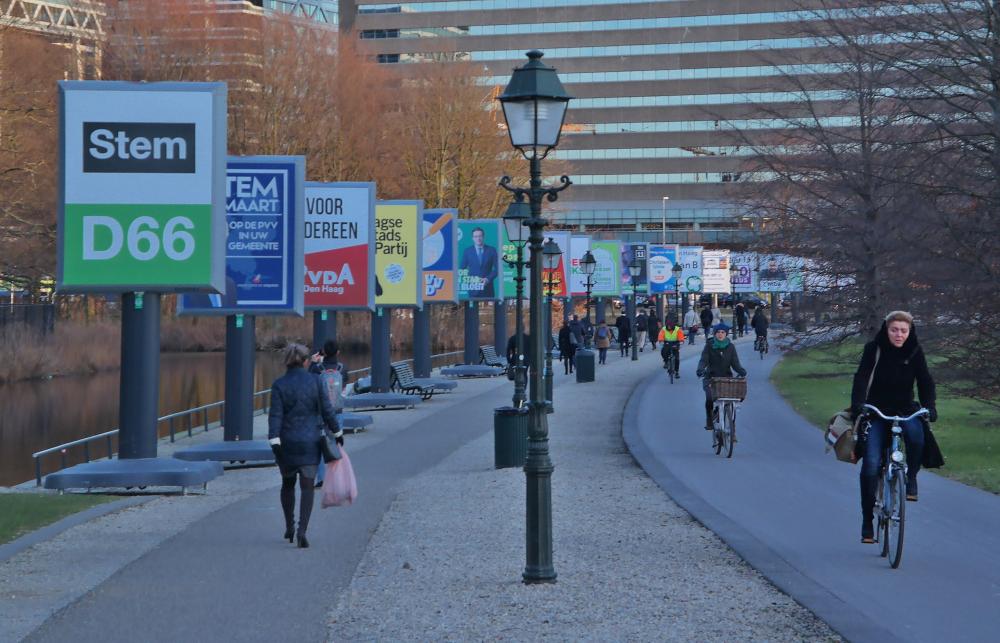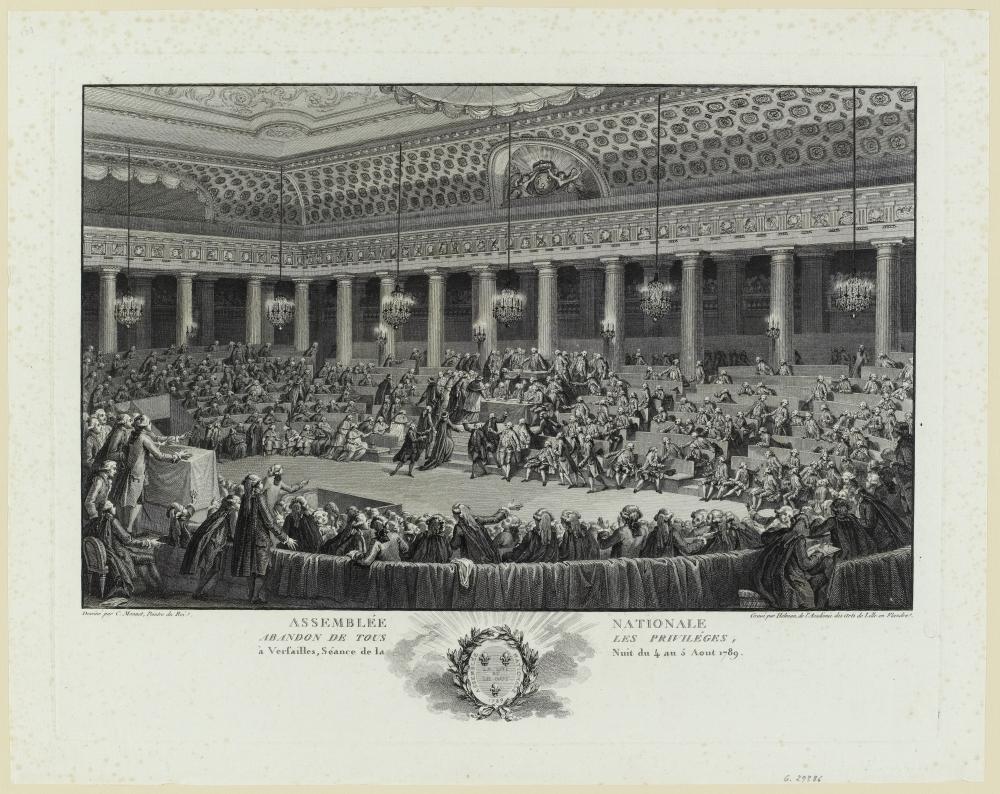Introduction
Popular media often portray political parties in cynical terms. Their positive features, however, remain: to allow citizens an organized means to engage in politics and to give voters a defined choice in the direction and policies they wish their country to have through free elections.

John Stuart Mill, the 19th century political philosopher who wrote On Liberty. Library of Congress Prints and Photographs.
While protest and social movements have been essential to expanding democracy and enhancing rights, political parties have been the indispensable vehicles for achieving that progress within a representative system of government. Today, citizens seeking change in democracies, including young people, look to political parties to achieve their goals, both through voting and pressure campaigns.
Political parties are formed reflecting the large spectrum of the people's views, interests, and needs ─ from their highest ideals to their basest instincts. Yet, as the 19th-century British philosopher John Stuart Mill suggests above, political parties in electoral democracies broadly represent two approaches: one for stability and one for change. Parties for stability try to preserve existing political, social and economic institutions and policies. Parties for change act to reform or, when necessary, radically alter them.
In Mills’ view, these approaches together achieve a “healthy state” within a polity. Most political theorists analyze political parties using this basic context. In history, however, such approaches at times achieved less healthy states. Parties of stability acted as reactionary forces to protect anti-democratic, repressive and hierarchical institutions. Parties of radical change sometimes brought new forms of tyranny. As indicated below, recent trends in multiparty systems have raised serious concerns among democracy specialists.
[T]wo hundred and fifty years of recent political history have shown that no democracy survives (or thrives) without a system in which the people are free to organize themselves into multiple, competing political parties
Still, two hundred and fifty years of recent political history have shown that no democracy survives (or thrives) without a system in which: (a) the people are free to organize themselves into multiple, competing political parties; (b) those parties may compete fairly for support among the citizenry in free elections; and (c) there is the real possibility for political parties to alternate power peacefully at regular intervals.
That same period of history demonstrates that when free and independent political parties are prevented from competing electorally or are forced to compete in unfair conditions, power becomes monopolized by single individuals, cliques, or one party in a manner that oppresses whole societies. When free and fair conditions for elections and voting are impeded, authoritarianism takes hold.
Democracy: Representative, Majoritarian & Universal
[W]hen free and independent political parties are prevented from competing electorally or are forced to compete in unfair conditions, power becomes monopolized by single individuals, cliques, or one party in a manner that oppresses whole societies.
The US Constitution established representative government based on the principle of majority rule. As James Madison wrote, such a republic was necessary as opposed to “direct democracy” in order to organize a larger polity beyond smaller communities. In this way, the American Revolution, together with the French Revolution soon thereafter, introduced modern democracy, in which the citizenry chooses their leaders through free elections.
The question of early representative government was who had the franchise, or right to vote, to choose representatives for the people as a whole. Although the United States expanded the franchise radically in relation to Great Britain, it still had a limited franchise in most states based on property and tax status, gender and race. Through the institution of slavery, one-fifth of the population was excluded entirely. The French Revolution adopted general manhood suffrage, but only briefly and by the 1795 Constitution the franchise was restricted by property, tax and other status.
The history of modern democracy is one of long and difficult struggles to expand the franchise, or the right to vote, to all persons equally regardless of race, ethnicity, gender, religion or other status .
The history of modern democracy is one of long and difficult struggles to expand the franchise, or the right to vote, to all persons equally regardless of race, ethnicity, gender, religion or other status (see History in Free Elections and Majority Rule, Minority Rights). Through such struggle, democracy became understood as it is today: representative government established through free and fair elections with equal and universal suffrage, operating on principles of majority rule and minority rights.
The Necessity of Political Parties
The other basic question from the start, however, was how people would choose their representatives. Many American Founders were hostile to the idea of political parties (the origin for today’s cynicism). James Madison's Federalist Papers No. 10 famously argued that the organization of "factions" (or parties) would pose a danger to the new union by creating division and encouraging disunity. He imagined that there would be a selection among the worthiest individuals in society.
This view, however, had no basis. It contrasted with the practice already in place in Great Britain, the nearest example for representative government on which the Founders had based much of the Constitution. There, parliament had divided between pro-monarchical Tories and pro-reform Whigs ─ one party for stability and one for change

The history of democracy is one of long struggle to expand the franchise. A frieze in the Monument to the Republic in Paris to the adoption of general manhood suffrage in 1848. Full universal suffrage including women was achieved only in 1945. Creative Commons License. Photo by Roi Boshi.
America’s early elections also demonstrated the need for political parties as representative instruments for competing ideas. Initially, the electorate divided to favor Federalists or anti-Federalists (supporters and opponents of a strong federal government). Madison himself, together with Thomas Jefferson, formed the Democratic-Republican Party in 1792 in opposition to the emerging Federalists. In France, factions of the National Assembly emerged after the 1789 Revolution that functioned as parties in subsequent elections.
In all countries, it was through the framework of a pluralist multiparty system and expansion of mass political parties that the legal expansion of suffrage and the representation of broader citizen interests were achieved.
In all countries where forms of representative government took hold, including the 18th century republics of Latin America, political parties became the means by which eligible voters chose representatives. These parties either defended or challenged established interests and institutions. Over time, they came to represent the broad and diverse interests of the people. Initially, these interests would be expressed through Conservative and Liberal parties defending aristocratic, landed or new industrial classes. They later would be expressed through socialist, social democratic and agrarian parties representing more mass interests of workers and small farmers (see History).
In all countries, it was through the framework of a pluralist multiparty system and expansion of mass political parties that the legal expansion of suffrage and the representation of broader citizen interests were achieved.
Types of Electoral Systems
The multiparty system has many variants, representing the history of the struggle for democracy in different countries (see History in this section and also in Free Elections). In democracies, political parties generally develop organically without specific constitutional provisions defining their number or nature. By contrast, a characteristic of many dictatorships is the establishment of the supremacy of one political party in the constitution.
In democracies, patterns of political party formation are influenced by a country's constitutional and electoral framework. For example, the United States has a presidential system and the United Kingdom a parliamentary system. Each, however, have similar electoral systems conducted (mostly) under a "first past the post" electoral system. The candidate with the most votes — whether a majority or a simple plurality — wins the electoral contest.
The multiparty system has many variants, representing the history of the struggle for democracy in different countries.
Legislative contests in both countries are held in geographically defined, single-member districts with (again, mostly) equal representation. In each system, this has tended toward two-party dominance since smaller parties cannot easily contest all districts on a national level. Smaller parties play a role to influence policy and even policies, but not generally to determine national governments. In both systems, the dominant parties incorporated within them a range of regional, ethnic, ideological, generational and class interests.
Some presidential and mixed presidential-parliamentary systems, however, have a different electoral system that requires multiple rounds of voting in national, legislative and other elections. In France, for example, there are run-off elections in both presidential and legislative elections by district between the two top vote getters when no candidate receives a majority in a first round of voting. Unlike “first past the post,” which allows a winner by plurality vote, the run-off electoral system fosters a larger multi-party and multi-candidate system, akin to parliamentary systems, with varied and competing interests and policy approaches. It then forces different parties to coalesce in the run-off vote, usually along a spectrum of right to left ideologies (see below).

The US and UK have a “first past the post” system. Some systems require run-off elections of the top finishers in a first round. In France, Emmanuel Macron (left) defeated Marine Le Pen in the 2017 and 2022 presidential run-off elections. Creative Commons License. Photo by: Foto-AG Gymnasium Melle.
US states differ in their electoral systems and some have run-off contests for different offices. A few US states have adopted a method called ranked-choice voting for different contests, by which voters rank candidates in order of preference to determine the final outcome. Those candidates with fewer votes have their voters’ next preferences counted in sequential rounds until one or the other top two candidates obtain a majority count. This also has the effect of encouraging competition of a greater number of parties and candidates.
Proportional Representation Systems
Parliamentary systems generally have proportional representation (PR). In this system, legislative seats are allocated according to a party's percentage of the vote nationally, regionally or locally. This type of system encourages a larger number of parties with defined interests and policy approaches to compete for seats since smaller parties may gain representation without having to defeat larger parties. A single party has the possibility to win a majority of seats to form a government, but usually coalitions of two or more parties are needed to obtain the necessary majority vote in parliament.
Some favor proportional systems because they allow defined differentiation of interests, whether ideological, economic, regional, ethnic, religious, social or cultural. But such diversity may also lead to difficulty in forming stable governing coalitions (see, for example, the Country Study of Israel in this section and of Netherlands in Majority Rule, Minority Rights).

Recent elections have brought about changing alignments in Dutch politics. Proportional systems allocate seats in parliament and municipal councils according to a party’s percentage of the vote. Above, election posters for 2018 Municipal Elections. Creative Commons License. Photo by Steven Lek.
All proportional representation systems have thresholds for the percentage of votes needed for political parties to enter parliament. In Democracy Web’s Country Studies, thresholds range from 0.67 percent of the vote (Netherlands) to 7 percent (in Turkey, lowered in the 2023 elections from 10 percent). More parties gain representation with lower threshold requirements (the Netherlands now has seventeen parties in parliament). Higher thresholds result in fewer parties gaining representation (Turkey had four coalition blocs that formed in order to achieve the 7 percent threshold).
Lower thresholds often allow parties representing minority populations to represent their communities (as now in Netherlands). High thresholds are adopted in some countries purposely to make it more difficult for parties representing minority populations to gain representation (the case in Turkey). Other countries adopt guaranteed representation of social, ethnic or national minorities and require specific gender percentages to ensure representation by women.
Some parliamentary systems (such as Hungary) have mixed systems with a portion allocated for direct mandate seats and a portion (usually a majority) for proportionally allocated seats or for regional multi-seat districts. Such systems tend to develop larger dominant parties or encourage coalitional blocs in elections so as to compete in all districts.
Platforms and Ideologies
Major political parties may be organized around charismatic politicians or, more commonly, around different ideologies or sets of ideas about the role of government and the organization of society. In the latter case, individuals join a party in order to support a party’s broad platform and direction, to help determine its policies in relation to ongoing political challenges, and to select the party’s representatives to run as candidates for elected office. While rules differ, political parties in democracies are mostly organized according to democratic principles (see Majority Rule, Minority Rights).
Parties are often grouped under broad labels according to their places on a political and ideological spectrum from left to right (see below). These terms arose originally from their use in the French Revolution. Those favoring a constitutional monarchy (and representing aristocratic interests) were seated on the right side of the national assembly hall; those favoring a citizens’ republic (representing more the radical demands of workers and commoners)
The Political Spectrum
As a result, “right” today generally encompasses several political groupings tending to support John Stuart Mill’s category of “stability” and so aim to protect traditional political, economic and social interests and institutions. In the United States, the Republican Party fits the category of “right” (although its origins were different). In Europe and elsewhere, this category includes Conservatives, Christian Democrats and Liberals. These parties all support free market economic principles and business interests but often differ on social issues and the role of religion in public life (see also History).

The origins of the terms “left” and “right” originate from the French Revolution, when those favoring monarchy would sit on the right and those favoring a republic on the left. The National Assembly meets in 1789 after the Revolution.
“Left” is used to categorize types of parties supporting “reform” or radical change. These tend to represent workers and support universal suffrage and egalitarianism, labor reforms and a strong state role in the economy. They include Social Democratic, Socialist, Labor and Social Christian parties. Also in this category are Green parties, which seek to preserve the planet and critique capitalism for failing to address the climate crisis. Agrarian, rural and ethnic or minority parties fall in the “left” or “right” category depending on the country. International organizations exist for major party types and are represented in regional or cross-regional bodies (see Resources).
[P]arties are considered to be on a broad center part of the spectrum for adhering to established democratic and governance norms and practices that have evolved since World War II.
Parties supporting a fully unregulated free market, the elimination of the welfare state, restrictions on human rights or nationalist or chauvinist policies are considered to the far Right on the spectrum. Those favoring full egalitarian distribution of wealth, social ownership of property, or other transformation of economic and social practices are considered farther to the Left.
In all categories, parties are considered to be on a broad center part of the spectrum for adhering to established democratic and governance norms and practices that have evolved since World War II. Those that challenge those norms are considered to be on the extreme ends.
Single Party Dictatorships
There are also ideological movements that reject the tenets of multiparty electoral democracy but exploit the system's freedoms and processes to gain power. These include fascist, extreme nationalist and religious fundamentalist parties, as well as Soviet and Chinese communist parties and their variants. The first three types are generally described as extreme Right and the latter types as extreme Left.
Dictatorships ruled by a single ideologically driven political party (such as Nazi Germany, the Soviet Union and the People’s Republic of China) have had the most oppressive forms of government.
In actuality, neither grouping is on the democratic spectrum and both are extremist in nature. All such parties are similar in that they have anti-democratic leaders or party leaderships and have comprehensive ideologies to justify the violent seizure of power and the imposition of total dictatorship.
Dictatorships ruled by a single ideologically driven political party (such as Nazi Germany, the Soviet Union and the People’s Republic of China) have had the most oppressive forms of government. These regimes are often called “totalitarian” because they control more completely political, social and economic life; they compel the citizenry to adhere to a ruling ideology; and they adopt a high level of repression, mass imprisonment and violence to suppress dissent and maintain control of the state and society.
Especially since World War II and the adoption by the United Nations of internationally recognized human rights standards, totalitarian and authoritarian regimes alike hold elections to claim democratic legitimacy. But such elections are sham processes. Other parties may exist but form part of a controlled “opposition” that allows the appearance of a multiparty system. Such regimes lack democratic characteristics (such as genuine multi-party contests, free or fair procedures, accountability and transparency, adherence to the rule of law and respect for human rights). They thus do not have consent of the governed.
A Foundational Framework: Protest & Politics
In democracies, political parties have been the basis on which citizens come together to represent political interests in common . . .a multiparty system is the only means by which such varied interests could be mediated in peaceful fashion, whether in a parliamentary, presidential or mixed system.
In democracies, political parties have been the basis on which citizens come together to represent political interests in common whether they be business or labor, professional or agricultural, social or cultural, ethnic or religious, regional or local, or simply ideological. A multiparty system is the only means by which such varied interests could be mediated in peaceful fashion, whether in a parliamentary, presidential or mixed system.
Free elections in which multiple parties contest for power are the opportunity for citizens to give a mandate to leaders and parties for implementing new policies. The multiparty system is also the means to hold political leaders and parties accountable if their policies fail to meet citizens’ needs or especially if they abuse power. In the end, it is the regular rotation of political parties in governance that allows for change and prevents entrenchment of interests.
In history, protest movements were necessary to press political parties to confront the need for fundamental change and to address gross inequalities and inequities within representative systems.
At the same time, political parties are often slow to address change and the multiparty system can become paralyzed when no clear majority or majority coalition of interests exists. This is when protest and politics often intersect. In history, protest movements were necessary to press political parties to confront the need for fundamental change and to address gross inequalities and inequities within representative systems. As can be seen in Country Studies, this was the case with the abolition of slavery, establishment of general manhood suffrage and women’s suffrage, and with civil and worker rights movements in the United States and other countries.
Still, political parties acting within representative government have been and remain the vehicles to achieve such change since it is through political parties that legislation and policies governing the whole of society are passed.
The Challenge to Essential Principles
As with other essential principles in Democracy Web, the multiparty system relies on the respect of political parties for the will of the people as expressed in elections (see, for example, Consent of the Governed).
As with other essential principles in Democracy Web, the multiparty system relies on the respect of political parties for the will of the people as expressed in elections
Dmocracy also relies on the understanding of political parties that win elections that they may find themselves in opposition after the next election. This understanding generally keeps ruling parties from abusing the rights of the people or their opponents so that they will also be protected when they are no longer in power (see also Majority Rule, Minority Rights).
While such principles are affirmed in most democracies, they are being severely challenged by leaders in others ─ often termed “backsliding democracies.” In those countries, ruling parties are infringing on minority rights, the rule of law and basic freedoms in order to maintain power. In countries with two-party dominant systems, like the United States, the danger is particularly high if one party begins to act anti-democratically in power (see Recent Trends in History).
The content on this page was last updated on .